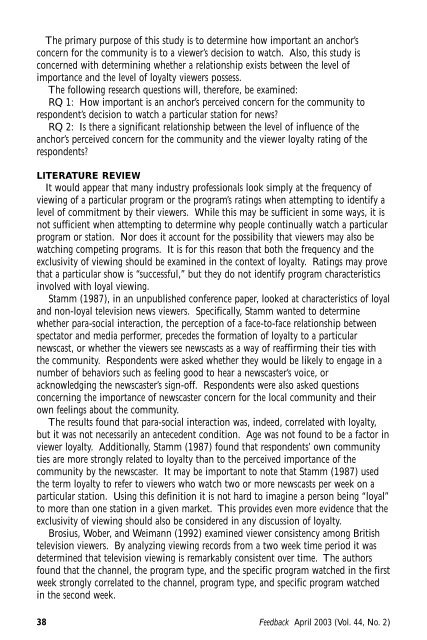APRILFeedback
Feedback April 2003 (Vol. 44, No. 2) - Broadcast Education ...
Feedback April 2003 (Vol. 44, No. 2) - Broadcast Education ...
- No tags were found...
Create successful ePaper yourself
Turn your PDF publications into a flip-book with our unique Google optimized e-Paper software.
The primary purpose of this study is to determine how important an anchor’sconcern for the community is to a viewer’s decision to watch. Also, this study isconcerned with determining whether a relationship exists between the level ofimportance and the level of loyalty viewers possess.The following research questions will, therefore, be examined:RQ 1: How important is an anchor’s perceived concern for the community torespondent’s decision to watch a particular station for news?RQ 2: Is there a significant relationship between the level of influence of theanchor’s perceived concern for the community and the viewer loyalty rating of therespondents?LITERATURE REVIEWIt would appear that many industry professionals look simply at the frequency ofviewing of a particular program or the program’s ratings when attempting to identify alevel of commitment by their viewers. While this may be sufficient in some ways, it isnot sufficient when attempting to determine why people continually watch a particularprogram or station. Nor does it account for the possibility that viewers may also bewatching competing programs. It is for this reason that both the frequency and theexclusivity of viewing should be examined in the context of loyalty. Ratings may provethat a particular show is “successful,” but they do not identify program characteristicsinvolved with loyal viewing.Stamm (1987), in an unpublished conference paper, looked at characteristics of loyaland non-loyal television news viewers. Specifically, Stamm wanted to determinewhether para-social interaction, the perception of a face-to-face relationship betweenspectator and media performer, precedes the formation of loyalty to a particularnewscast, or whether the viewers see newscasts as a way of reaffirming their ties withthe community. Respondents were asked whether they would be likely to engage in anumber of behaviors such as feeling good to hear a newscaster’s voice, oracknowledging the newscaster’s sign-off. Respondents were also asked questionsconcerning the importance of newscaster concern for the local community and theirown feelings about the community.The results found that para-social interaction was, indeed, correlated with loyalty,but it was not necessarily an antecedent condition. Age was not found to be a factor inviewer loyalty. Additionally, Stamm (1987) found that respondents’ own communityties are more strongly related to loyalty than to the perceived importance of thecommunity by the newscaster. It may be important to note that Stamm (1987) usedthe term loyalty to refer to viewers who watch two or more newscasts per week on aparticular station. Using this definition it is not hard to imagine a person being “loyal”to more than one station in a given market. This provides even more evidence that theexclusivity of viewing should also be considered in any discussion of loyalty.Brosius, Wober, and Weimann (1992) examined viewer consistency among Britishtelevision viewers. By analyzing viewing records from a two week time period it wasdetermined that television viewing is remarkably consistent over time. The authorsfound that the channel, the program type, and the specific program watched in the firstweek strongly correlated to the channel, program type, and specific program watchedin the second week.38Feedback April 2003 (Vol. 44, No. 2)
















